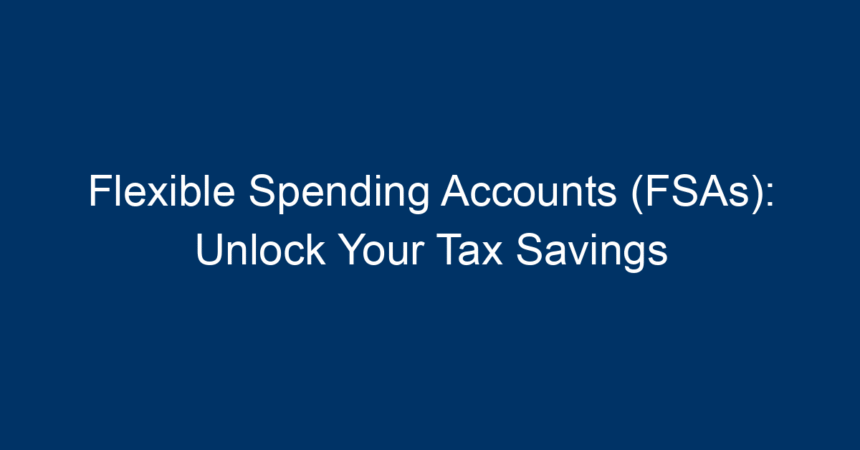In today’s financially-driven world, maximizing your savings is more essential than ever. One of the most effective tools available for individuals to reduce their tax burden is a Flexible Spending Account (FSA). This tax-advantaged account not only helps you budget for healthcare costs but also provides an opportunity to save money overall. Let’s dive deeper into how flexible spending accounts (FSAs) work, their benefits, eligibility criteria, and tips for making the most of them.
What Are Flexible Spending Accounts (FSAs)?
Flexible Spending Accounts (FSAs) are employer-sponsored financial accounts that allow employees to set aside pre-tax dollars for qualifying healthcare expenses. This means that the money you contribute to an FSA is deducted from your gross income, lowering your taxable income and ultimately your tax bill.
How Do FSAs Work?
When you enroll in a flexible spending account (FSA), you decide how much money to allocate for the year. The maximum contribution limit is set annually by the IRS. For 2023, the limit is $3,050. Once you decide on your contribution, your employer deducts this amount from your paycheck before taxes are calculated.
Use-It-or-Lose-It Rule
One important aspect of FSAs to keep in mind is the “use-it-or-lose-it” rule. Typically, any unused funds in your account at the end of the plan year are forfeited. However, some employers offer a grace period of up to two and a half months to use remaining funds or allow a rollover of up to $610 into the following year.
Benefits of Flexible Spending Accounts (FSAs)
Flexible spending accounts (FSAs) offer numerous benefits that can enhance your financial well-being:
1. Tax Savings
Because contributions are made using pre-tax dollars, the money you contribute to your FSA reduces your taxable income. This means that you pay fewer taxes overall, resulting in significant savings, especially for high earners.
2. Budgeting for Healthcare Costs
Healthcare can be unpredictable. FSAs allow you to plan ahead, enabling you to set aside money for anticipated medical expenses, such as deductibles, co-pays, or prescriptions. This budgeting aspect makes healthcare management easier and less stressful.
3. Immediate Access to Funds
With a flexible spending account (FSA), all contributed funds are available at the beginning of the plan year. This means you can use the full amount—even if you haven’t contributed all of it yet. This feature can be especially useful if you anticipate high medical expenses early in the year.
4. No Social Security Tax
Unlike regular income, contributions to an FSA are not subject to Social Security taxes. This adds another layer of savings, resulting in more money remaining in your pocket.
Qualifying Expenses for FSAs
Understanding which expenses are eligible is crucial to fully benefiting from flexible spending accounts (FSAs). Here’s a list of common qualifying expenses:
Medical Expenses
- Doctor Visits: Co-pays and out-of-pocket expenses for medical services.
- Prescription Drugs: Over-the-counter medicines with a doctor’s note.
- Dental and Vision Care: Costs such as braces, fillings, eye exams, and glasses.
Specialized Treatments
- Physical Therapy: Treatments prescribed by a healthcare professional.
- Chiropractic Care: Adjustments and sessions covered under healthcare plans.
- Acupuncture: Approved sessions that fall under medical treatments.
Dependent Care Expenses
Some FSAs also allow funds to be used for dependent care expenses. Individuals can use these accounts to pay for:
- Childcare Services: Daycare, nursery schools, and after-school programs for children under 13.
- Adult Daycare Services: For dependents who are unable to care for themselves due to disability.
Eligibility for FSAs
Most employers offer flexible spending accounts (FSAs) to their employees, but eligibility can vary. Here are the primary criteria:
Employment Status
FSAs are typically only available to active employees of an organization. If you work part-time, some employers may offer them, while others may not.
Enrollment Periods
You must enroll during the designated open enrollment period. This is usually at the end of the year or upon starting a new job. After the enrollment period, you cannot change your contribution unless you experience a qualifying life event.
Tips to Maximize Your FSA Benefits
To make the most of flexible spending accounts (FSAs), consider the following strategies:
1. Plan Wisely
Estimate your annual medical expenses before deciding how much to contribute. Use historical expenses as a reference, and consider upcoming healthcare needs.
2. Keep Track of Expenses
Maintain records of all receipts and expenses associated with your FSA. This will make it easier to manage your funds and ensure you utilize your benefits fully.
3. Take Advantage of Grace Periods
If your employer allows for a grace period, use it to spend any remaining balance. This can help you avoid losing any funds at the end of the year.
4. Consider Possible Rollover Options
If your employer offers a rollover option, be sure to take advantage of it. This can allow you to move unused funds into the next plan year, mitigating the “use-it-or-lose-it” concern.
Conclusion: Unlock Your Tax Savings Today!
In a world where every dollar counts, flexible spending accounts (FSAs) provide an excellent opportunity to reduce your tax burden and make healthcare costs more manageable. By understanding how FSAs work, their benefits, eligibility requirements, and strategies for maximizing contributions, you can effectively unlock significant tax savings.
Take the time to assess your healthcare needs, consult with your employer regarding available options, and enroll during open enrollment periods. By making informed decisions today, you can pave the way for a healthier and financially secure tomorrow!
Call to Action
Ready to maximize your tax savings with flexible spending accounts (FSAs)? Consult your HR department to explore your options and start taking full advantage of this incredible financial tool today!




